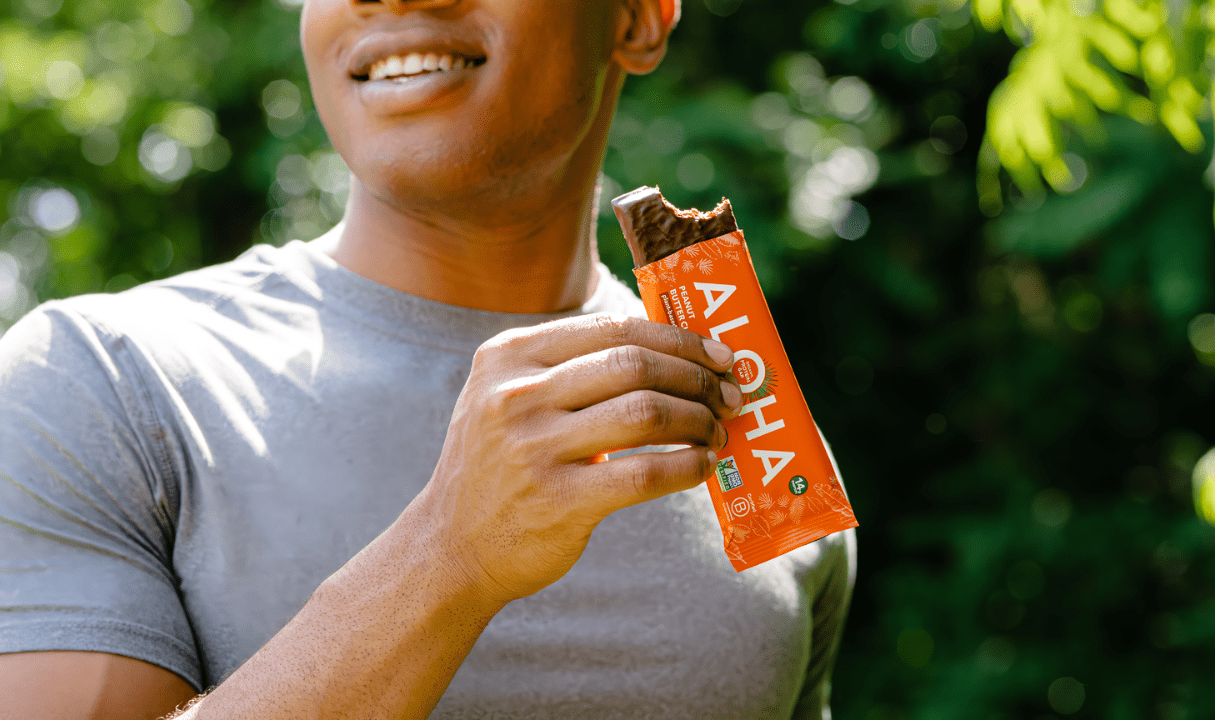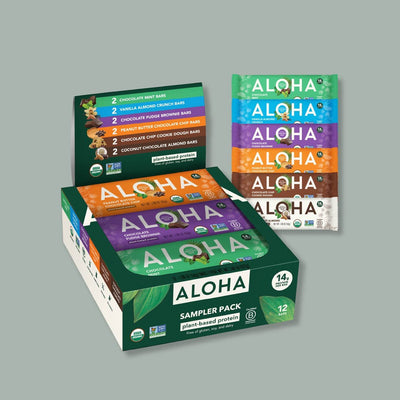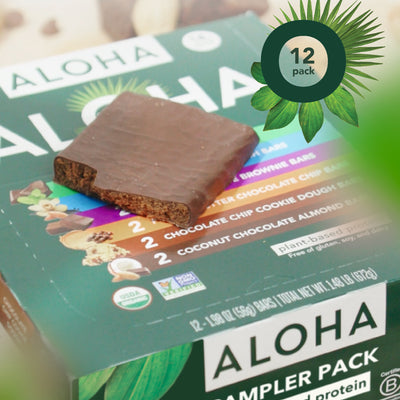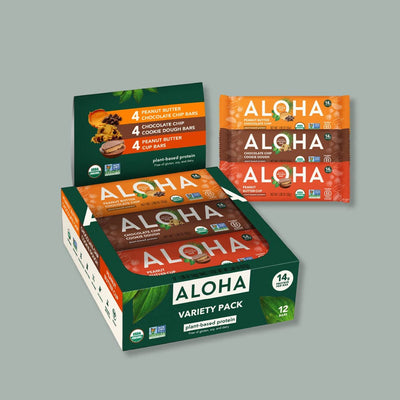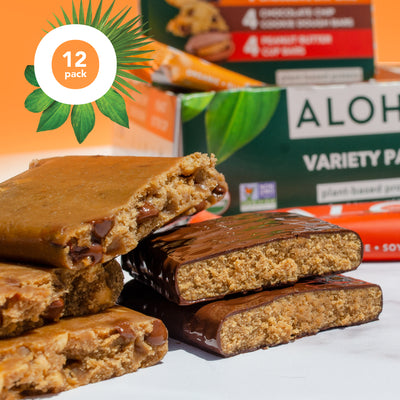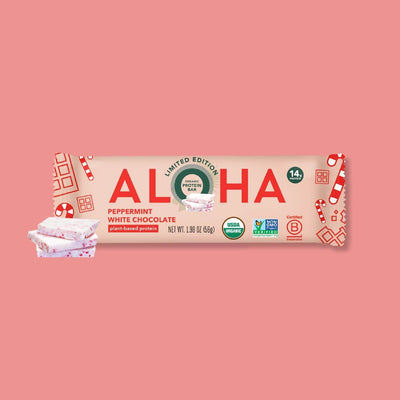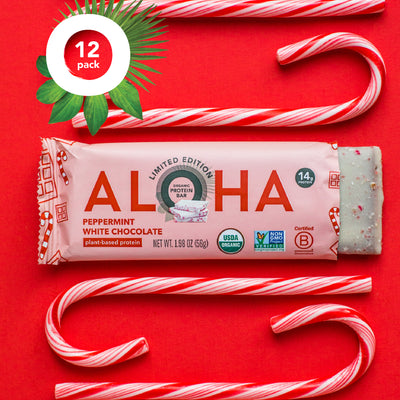Key Takeaways:
- Gradual Transition: Start by replacing dairy with plant-based alternatives, making the switch to a dairy-free lifestyle smoother and more sustainable.
- Nutritional Balance: Ensure adequate intake of essential nutrients like calcium and vitamin D by incorporating fortified plant-based products and diverse foods into your diet.
- Health Benefits: Eliminating dairy can lead to improved digestion, clearer skin, and reduced inflammation, contributing to overall better health.
At ALOHA, we’ve mastered creating plant-based, organic, and non-GMO nutritional products that nourish your body and delight your taste buds. We are committed to supporting your journey towards a healthier lifestyle, whether you’re an athlete, a busy professional, or simply someone who values wholesome, delicious nutrition. Our expertise in crafting high-quality, dairy-free alternatives makes us the go-to source for those looking to eliminate dairy from their diets while still enjoying satisfying and nutritious foods.
Cutting dairy from your diet is a significant step that can lead to better digestion, improved skin, and a more sustainable lifestyle. However, careful consideration is also required to ensure you get the necessary nutrients. From understanding the reasons to go dairy-free to exploring delicious alternatives and maintaining a balanced diet, this guide is designed to make your transition as smooth and enjoyable as possible.
In this piece, we’ll walk you through everything you need to know about cutting dairy out of your diet and how to thrive with delicious, plant-based alternatives.
Understanding The Reasons To Cut Dairy From Your Diet
Eliminating dairy from your diet can significantly benefit your health and overall well-being. Many people go dairy-free due to lactose intolerance, a condition where the body cannot digest lactose, leading to discomfort and digestive issues. Others might cut out dairy to reduce inflammation, as studies suggest that dairy can trigger certain inflammatory conditions. Additionally, many individuals eliminate dairy for ethical reasons, such as animal welfare and environmental sustainability concerns.
Another compelling reason to reduce or eliminate dairy is to explore the potential for clearer skin. Some research links dairy consumption to acne and other skin issues, particularly those sensitive to dairy products. By cutting out dairy, you may notice improvements in your skin's appearance and overall health.
Lastly, moving away from dairy allows you to discover and enjoy a wide variety of plant-based alternatives that are rich in nutrients and can enhance your diet. These alternatives cater to specific dietary needs and are committed to more sustainable and ethical food choices.
Identifying Common Sources Of Dairy In Your Diet
- Common Dairy Ingredients in Processed Foods - Dairy is often hidden in processed foods under different names, making it tricky to avoid. Ingredients like casein, whey, lactose, and milk solids are all dairy derivatives. They can be found in various products, from snack foods and baked goods to soups and sauces. Always check labels carefully for these ingredients when eliminating dairy from your diet.
- Dairy in Sauces and Dressings - Many sauces and dressings, including popular options like ranch, Alfredo, and certain vinaigrettes, contain cream, cheese, or milk. Even seemingly dairy-free options may include dairy derivatives, so reading ingredient lists closely is crucial. Opt for dairy-free versions or make your own at home to ensure they fit into your dairy-free diet.
- Dairy in Baked Goods - Baked goods like bread, pastries, and cookies often contain butter, milk, or other dairy ingredients. Even some breads that appear simple may have added milk powder or butter. When buying baked goods, look for labels stating they are dairy-free or consider baking at home with plant-based alternatives.
- Hidden Dairy in Unexpected Products - Dairy can also be found in unexpected places like flavored chips, sure chocolates, and some medications. It’s important to be vigilant and investigate any product that doesn’t clearly state dairy-free. Many foods that seem safe can still contain dairy, so it’s always better to double-check.
Exploring Delicious Dairy-Free Alternatives
Cutting dairy from your diet opens up a flavorful and nutritious alternative that can easily replace your favorite dairy products. From protein bars to rich coconut yogurt, there are plenty of options to satisfy your cravings without compromising taste or texture.
Dairy-Free Protein Bars
For those looking to maintain a balanced diet and stay energized, ALOHA’s dairy-free protein bars offer a convenient and tasty option. These bars are crafted with plant-based ingredients and come in various flavors, making them a perfect on-the-go snack.
Dairy-Free Protein Drinks
Stay refreshed and nourished with ALOHA’s dairy-free protein drinks. These drinks are packed with plant-based protein and come in convenient, ready-to-drink formats that are perfect for post-workout recovery or a quick meal replacement.
Dairy-Free Protein Powders
ALOHA's dairy-free protein powders provide a versatile and delicious option for those who prefer to mix their own shakes or add protein to recipes. These powders are made from high-quality, plant-based ingredients and are free from dairy, making them a great addition to any dairy-free diet.
Dairy-Free Cheese Options
Cheese lovers don’t have to miss out when going dairy-free. Numerous dairy-free cheese options are made from ingredients like nuts and even potatoes. These alternatives melt, stretch, and taste remarkably like traditional cheese, making them perfect for pizzas, sandwiches, and more. Explore options like cashew cheese, soy-based mozzarella, and even plant-based cream cheese spreads.
Yogurt And Ice Cream Alternatives
For those who enjoy yogurt and ice cream, plenty of dairy-free versions are available that are just as creamy and satisfying. Coconut, almond, and cashew milk often create rich, flavorful, dairy-free yogurts and ice creams. These alternatives are available in various flavors, ensuring you can still enjoy your favorite treats without the dairy.
Butter And Cream Replacements
Replacing butter and cream in your diet is easier than ever with the variety of plant-based spreads and creams available. Vegan butter from coconut, olive, or avocado offers the same rich taste and texture as dairy butter. For cooking and baking, coconut cream and cashew cream provide excellent substitutes for heavy cream, allowing you to enjoy creamy dishes without the dairy.
Tips For Transitioning To A Dairy-Free Lifestyle
Transitioning to a dairy-free lifestyle can be a smooth and rewarding process with the right approach. Here are some practical tips to help you make the switch without feeling overwhelmed:
Start Gradually
Transitioning to a dairy-free lifestyle is often easier when done gradually. Begin by eliminating dairy from one meal daily, such as swapping your morning milk for almond or oat milk in your coffee or cereal. Over time, you can extend this change to other meals, allowing your palate and body to adjust more comfortably. This step-by-step approach helps prevent feeling overwhelmed and increases your chances of long-term success.
Experiment With Dairy-Free Recipes
Exploring dairy-free cooking can be an exciting culinary journey. Try different recipes using plant-based alternatives to recreate your favorite dishes without dairy. Experimenting in the kitchen lets you discover new flavors and textures you might not have considered before. The transition becomes enjoyable and sustainable as you find and perfect your favorite dairy-free meals.
Stock Up On Dairy-Free Staples
Keeping your kitchen well-stocked with dairy-free staples is crucial for a smooth transition. Items like plant-based milk, vegan butter, and dairy-free cheeses should always be on hand to replace traditional dairy products. This preparation ensures you’re not caught off guard when preparing meals, making it easier to stick to your new dietary choices. Having these essentials readily available reduces the temptation to revert to dairy.
Be Mindful When Dining Out
Eating out while avoiding dairy can be tricky, but it's manageable with some planning. Research restaurants beforehand to find dairy-free options, or ask your server about modifying dishes to meet your needs. Don’t hesitate to communicate your dietary preferences; many restaurants are increasingly accommodating to dietary restrictions. Being prepared helps you enjoy dining out without compromising your dairy-free lifestyle.
Listen To Your Body
As you eliminate dairy, pay attention to your body's signals. You might notice improvements such as reduced bloating, clearer skin, or increased energy levels. These positive changes can reinforce your decision to stay dairy-free and encourage you to continue exploring dairy-free alternatives. Monitoring your feelings allows you to adjust and tailor your diet to your needs better.
Nutritional Considerations When Eliminating Dairy
Ensuring Adequate Calcium Intake
When you remove dairy from your diet, it’s essential to find alternative sources of calcium, which is crucial for bone health. Leafy greens like kale, broccoli, and fortified plant-based milks can provide substantial amounts of calcium. Additionally, some tofu varieties are calcium-set, making them an excellent dairy-free source of this vital mineral. Incorporating these foods into your diet helps maintain strong bones and overall health.
Maintaining Sufficient Vitamin D Levels
Vitamin D is another nutrient commonly associated with dairy products, particularly fortified milk. To maintain adequate vitamin D levels, spend time outdoors in sunlight, which naturally helps your body produce this vitamin. Additionally, look for plant-based milks and other fortified foods that provide vitamin D, or consider taking a supplement, especially during the winter months when sunlight exposure is limited.
Meeting Protein Needs On A Dairy-Free Diet
Protein is a key nutrient easily obtained from plant-based sources when dairy is removed from your diet. Foods like beans, lentils, nuts, seeds, and quinoa are protein-rich and provide all the essential amino acids your body needs. Incorporating various foods into your meals ensures your diet remains balanced and nutritionally complete.
Getting Omega-3 Fatty Acids Without Dairy
Omega-3 fatty acids are essential for heart and brain health and are commonly found in fish and dairy products. You can obtain omega-3s from plant-based sources such as flaxseeds, chia seeds, and walnuts on a dairy-free diet. These foods are rich in alpha-linolenic acid (ALA), a type of omega-3 that supports overall health and helps reduce inflammation.
Final Thoughts
Transitioning to a dairy-free lifestyle is more than just a dietary change; it’s an empowering step toward embracing better health and ethical choices. As you move away from dairy, you open the door to various nutritious, plant-based alternatives that support your body’s needs and contribute to a more sustainable future. The journey may require some adjustments, but with the abundance of delicious options available, living dairy-free can be both satisfying and rewarding.
At ALOHA, we understand the importance of making informed and conscious choices for your well-being. Our range of dairy-free products is designed to make your transition smooth, enjoyable, and aligned with your health goals. As you explore these alternatives, remember that every small change contributes to a healthier and more compassionate world. Embrace this new chapter confidently, knowing you’re nourishing your body while staying true to your values.
Read also:
- Lunch Box Ideas For Adults That Don't Have Time To Cook
- How To Increase Your Protein Intake: Tips And Tricks
- How Many Protein Bars Can You Eat In A Day?
Frequently Asked Questions About How To Cut Dairy Out Of Your Diet
What are some easy first steps to start cutting dairy out of my diet?
Begin by substituting your regular milk with plant-based alternatives like almond, oat, or soy milk. Gradually replace other dairy products, like yogurt and cheese, with their dairy-free counterparts.
Are dairy-free alternatives nutritionally comparable to dairy products?
Yes, many dairy-free alternatives are fortified with essential nutrients like calcium and vitamin D. However, reading labels and ensuring a balanced diet is essential.
Can cutting dairy out of my diet improve skin health?
Some people experience clearer skin after eliminating dairy, as dairy can sometimes be linked to acne and other skin issues. However, results can vary based on individual health conditions.
What are the best dairy-free alternatives for baking?
For baking, you can use plant-based milks, vegan butter, and flax or chia seeds mixed with water as egg replacements. Coconut cream or cashew cream can be a substitute for heavy cream.
How do I ensure I'm getting enough calcium without dairy?
Include calcium-rich plant foods like leafy greens, fortified plant-based milks, and tofu. These can help meet your calcium needs without dairy.
What are some hidden sources of dairy in processed foods?
Dairy can hide under names like whey, casein, lactose, and milk solids. Always check labels on processed foods, sauces, and even some medications to avoid hidden dairy.
Is it possible to dine out while avoiding dairy?
Yes, with some planning. Research restaurants with dairy-free options or ask your server about modifying dishes. Many places now cater to dairy-free diets.
What are the benefits of cutting dairy out of my diet?
Benefits may include improved digestion, clearer skin, and reduced inflammation. Additionally, you might discover a range of new, delicious plant-based foods.
Are there dairy-free cheeses that melt and taste like real cheese?
Absolutely! Many dairy-free cheeses made from nuts or soy melt, stretch, and taste similar to traditional cheese, making them great for pizzas, sandwiches, and more.
How can I replace cream and butter in my cooking?
Vegan butter made from coconut or olive oil work well as substitutes, and coconut cream or cashew cream can replace heavy cream in recipes, providing rich texture and flavor.
Sources:
- Adamczyk, D., Jaworska, D., Affeltowicz, D., & Maison, D. (2022). Plant-Based Dairy Alternatives: Consumers’ Perceptions, Motivations, and Barriers—Results from a Qualitative Study in Poland, Germany, and France. Nutrients, 14(10), 2171. https://doi.org/10.3390/nu14102171
- MD, T. C. (2014, December 12). How to Get Calcium Without Dairy. Center for Nutrition Studies. https://staging.nutritionstudies.org/how-to-get-calcium-without-dairy/
- Li, A., Zheng, J., Han, X., Yang, S., Cheng, S., Zhao, J., Zhou, W., & Lu, Y. (2023). Advances in Low-Lactose/Lactose-Free Dairy Products and Their Production. Foods, 12(13), 2553–2553. https://doi.org/10.3390/foods12132553
- Plamada, D., Bernadette-Emőke Teleky, Nemes, S.-A., Mitrea, L., Szabo, K., Lavinia-Florina Călinoiu, Mihaela Stefana Pascuta, Varvara, R.-A., Călina Ciont (Nagy, Gheorghe Adrian Martău, Simon, E., Barta, G., Francisc Vasile Dulf, Dan Cristian Vodnar, & Nitescu, M. (2023). Plant-Based Dairy Alternatives—A Future Direction to the Milky Way. Foods, 12(9), 1883–1883. https://doi.org/10.3390/foods12091883
ALOHA's products are not intended to treat, diagnose, mitigate, prevent, or cure disease. ALOHA's products should not replace prescribed medications or the variety of foods important to a healthful diet.
Do not self-diagnose any health condition. Work with your healthcare provider to determine how best to achieve optimal health.

